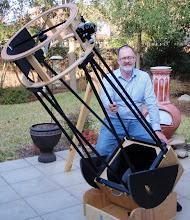Today, I want to explore using the iPad for astronomy. I recently bought the new Apple device and want to share some of what I have learned about the sorts of things
I do with it for astronomy.
First, a couple parameters: I am using the least expensive of the iPad models. The 16 gig iPad without 3G connection. I already carry an iPhone that allows connection with the phone system, so I decided to get the iPad to see what it would do by itself.
I'm presently typing this on the iPad using the Pages application. I could have typed it directly onto the blog entry box, but I wanted to see if the Pages app gave any more flexibility in spelling correction and formatting.
So far, the word processing app does not seem any better or worse than typing directly. However I am also aware that I will have a semi-permanent version of the blog post available to me.
I have chosen to type this in the profile format with two thumbs instead of the landscape mode with many fingers. I find that it is almost as fast for me to type with my thumbs as with several fingers. Occasionally, the self corrector gets confused. Somehow, at the end of the previous sentence it changed fingers to Gershwin!
All the iPhone apps I use for astronomy work fine with the iPad. Significantly, this means that GoSatWatch, ProSat, StarWalk, and Starmap Pro all work. The Starmap program is a very powerful planetarium program that has almost all the faint fuzzes as well as the moons of the planets charted for any time. Unfortunately, the pro version is not yet available on the iPad. However the iPhone version does work well enough on the iPad.
These programs work well even when there is no connection to the Internet via a WiFi connection. There are other programs that are often useful on an iPhone which suffer in the field without connection. Weather programs like Weather Bug have much better displays, especially of radar and cloud maps on the iPad version, but they don't display current weather when disconnected, of course. The same is true of solar reports on the Space Weather site.
PDFs of books are easy to read in their native format, straight off the scanner. There is a kindle app that allows all the kindle books to be viewed at greater resolution than on the original Amazon device.
So that is a pretty quick rundown of what I have seen so far in the sorts of uses that I have put the iPad through with astronomy in mind. I'd strongly recommend the device over a laptop computer for astronomy amateurs who do not need the specialized programs used by imagers.
Oh, did I mention that the battery lasts for about 10 hours? That was the best discovery!
Sunday, May 23, 2010
Subscribe to:
Posts (Atom)

